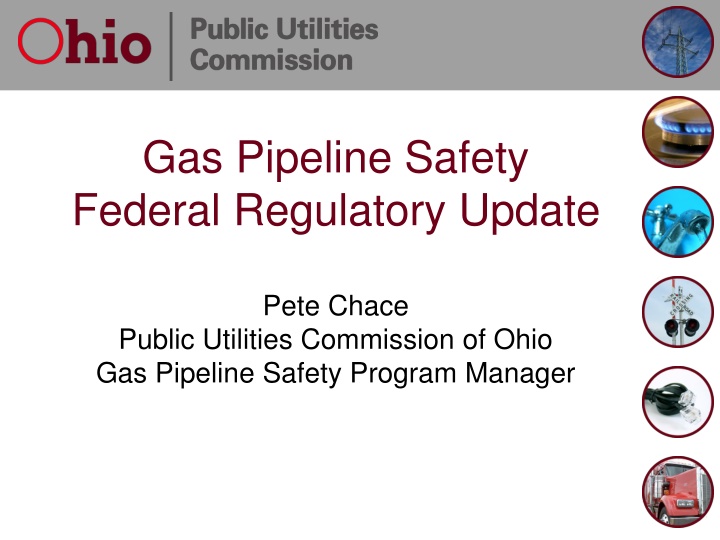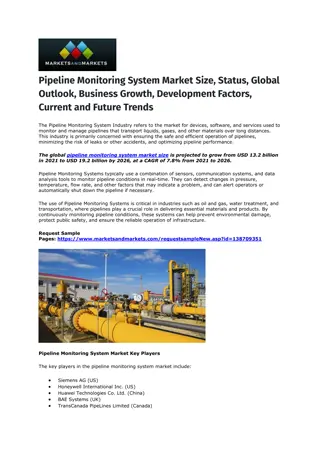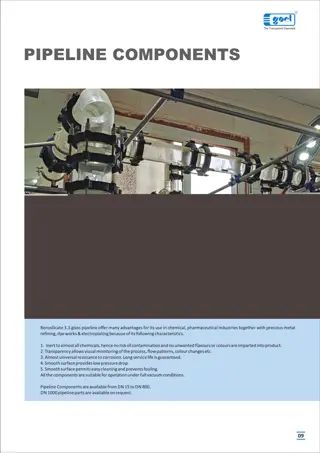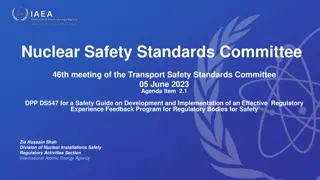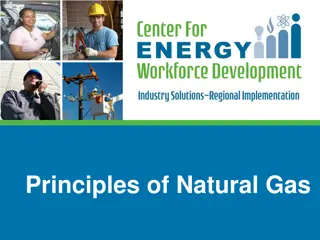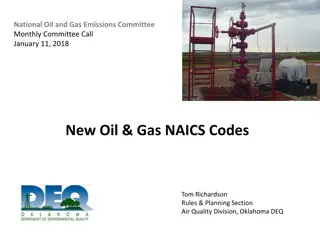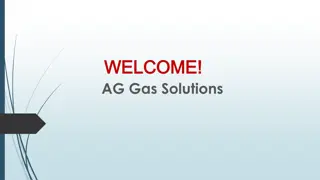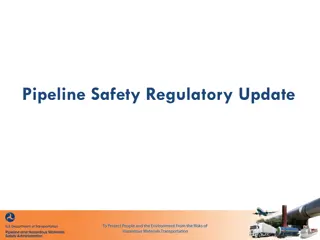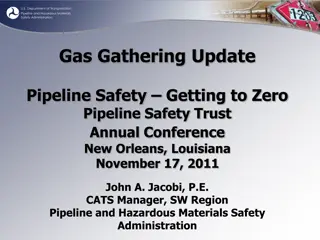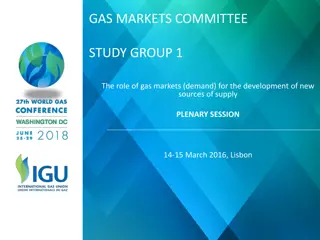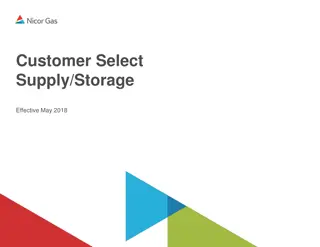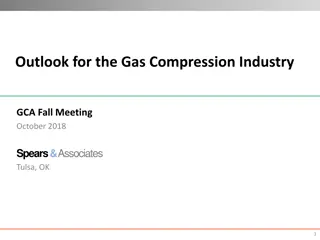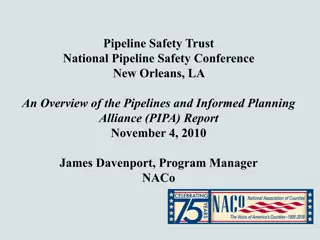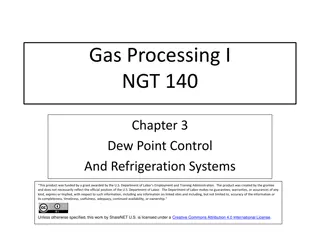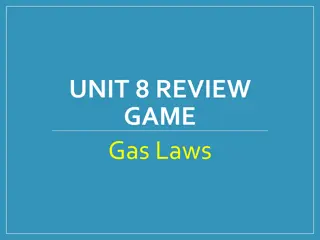Gas Pipeline Safety Regulatory Updates & NPRMs Overview
Stay informed about the latest federal regulatory updates in gas pipeline safety, including the Federal Rulemaking Process, Gas Transmission & Gathering Lines NPRM, Excess Flow Valves for Multi-person Dwellings NPRM, Rupture Detection & Valves Rule NPRM, Plastic Pipe NPRM, and Operator Qualifications NPRM. Learn about key changes, timelines, and implications for pipeline safety programs.
Download Presentation

Please find below an Image/Link to download the presentation.
The content on the website is provided AS IS for your information and personal use only. It may not be sold, licensed, or shared on other websites without obtaining consent from the author.If you encounter any issues during the download, it is possible that the publisher has removed the file from their server.
You are allowed to download the files provided on this website for personal or commercial use, subject to the condition that they are used lawfully. All files are the property of their respective owners.
The content on the website is provided AS IS for your information and personal use only. It may not be sold, licensed, or shared on other websites without obtaining consent from the author.
E N D
Presentation Transcript
Gas Pipeline Safety Federal Regulatory Update Pete Chace Public Utilities Commission of Ohio Gas Pipeline Safety Program Manager
Federal Rulemaking Process Legislation Congress passes a law that prescribes general goals for the agency. Advance Notice of Proposed Rulemaking (ANPR) agency publishes initial analysis of legislative intent and asks for public comment (optional). Notice of Proposed Rulemaking (NPRM) agency publishes proposed rule language after review by Federal Office of Management & Budget (OMB), with a public comment period. Final Rule published with response to issues raised by public comment, subject to judicial review
Gas Transmission and Gathering Lines NPRM released 3/15/16, 60 day comment period. New assessment and repair criteria for transmission lines, MAOP verification, revised IM requirements, changes to corrosion control, extended regulation of Gathering lines, safety features on launchers and receivers.
Excess Flow Valves for Multi-person Dwellings NPRM from 7/15/15 Requires EFV s to be installed for certain structures other than single family dwellings (multi-family residences and small commercial consuming volumes < 1,000 SCFH. PHMSA currently projects this rule to be published January 2017.
Rupture Detection and Valves Rule NPRM expected 7/27/16 Installation of automatic shutoff valves or equivalent technology, and establish performance based metrics for rupture detection for gas and liquid Transmission lines. For HCA s, Class 3, 4 locations.
Plastic Pipe NPRM issued 5/21/15. Addresses composite pipe, 50 year markings, increased design factor for PE pipe (.32 to .40), authorized use of PA12 at higher pressures, tracking and traceability of lines, incorporates revised standards.
Operator Qualifications NPRM issued 7/10/15. Operator Qualification for new construction, two part test , incident reporting requirement changes, cost recovery and special permit language.
Excavation Damage Prevention NPRM issued 7/23/15 Defines criteria for determining if a State enforcement program for its excavation damage prevention laws is Effective, and allows for PHMSA enforcement if not.
Gas Transmission NPRM Reporting requirements (Part 191) Repeals reporting requirement exemption for unregulated onshore gathering lines (including annual and incident reports) Defines an MAOP exceedance that exceeds allowable buildup (192.201) as a Safety Related Condition, subject to the reporting requirements in 191.25.
Gas Transmission NPRM Gathering Line requirements RP80 is no longer used to define Gathering lines. Extends regulation to Type A Gathering lines in Class 1 locations, for lines that are 8 or greater. Newly regulated class of lines must follow the same requirements as currently exists for Type B Gathering.
Gas Transmission NPRM Record Keeping Requirements Transmission operators must retain mill records, pressure test records, welder qualification records, valve and other component records, class location records, etc. for the life of the pipeline. New section 192.13(d) requires all Transmission operators to have a Management of Change program as per ASME B31S
Gas Transmission NPRM MAOP Verification Moderate Consequence Area is an area in a Potential Impact Circle containing 5 or more buildings, an occupied site, or a right-of-way for a freeway, and otherwise does not meet the definition of a High Consequence Area. Legacy Construction Techniques (coupled pipe, wrinkle bends, etc.) and Legacy Pipe (LF-ERW, etc.) are defined.
Gas Transmission NPRM MAOP Verification 192.619 requires areas with inadequately documented MAOP (2012 Annual Report) to re-establish MAOP. 192.624 requires operators to re- establish MAOP for pipelines in a HCA or MCA. Method is Spike Test for Legacy pipe, Pressure Test for Modern pipe. Other methods may be allowed such as derating, engineering critical assessment, certain in-line assessments.
Gas Transmission NPRM MAOP Verification New 192.607 Verification of Pipeline Material . Defines non-destructive techniques, requires material verification for pipelines that do not have reliable, traceable, verifiable and complete documentation when the pipeline is exposed, or for HCA and Class 3, 4 locations. Operators have to have a Material Documentation Plan .
Gas Transmission NPRM MAOP Verification New 192.710. Transmission lines in Class 3 or 4 locations, or in a MCA, must be assessed within 15 years, and every 20 years thereafter. Assessment may be ILI, pressure testing, excavation and examination, guided wave ultrasonic testing, direct assessment (only if the line is not pig-able).
Gas Transmission NPRM Cathodic Protection Transmission operators must perform an above ground indirect assessment to locate moderate to severe coating damage. Transmission operators must conduct surveys for interference currents and remediate. Quarterly gas monitoring required for internal corrosion. (All operators) interpretation that prompt remedial action means the next monitoring interval or 1 year, whatever is less. Transmission operators must perform a close interval survey for low CP reads.
Gas Transmission NPRM Repair of damages and leaks General requirements modified to require a 20% pressure reduction when a condition presents an immediate hazard . Establishes immediate, 2-year, and monitored conditions for imperfections and damages outside of HCA s.
Gas Transmission NPRM Pig Launching and Receiving New 192.750 Launcher and Receiver Safety section requires pig launchers and receivers o have suitable means to indicate barrel pressure and to relieve pressure in the barrel. New 192.493 incorporates standards by reference for in-line inspection. API STD 1163-2005 In-Line Inspection System Qualification Standard NACE SP0102-2010 In-Line Inspection of Pipelines ANSI ILI-PQ-2005 In-Line Inspection Personnel Qualification and Certification .
Gas Transmission NPRM Integrity Management Direct assessment only allowed on un-piggable lines. Adds Spike test, GWUT, excavation with direct examination as assessment methods. Incorporates NACE SP0206-2006 for Internal Corrosion Direct Assessment Incorporates NACE SP0204-2008 for stress corrosion cracking direct assessment. Expands the list of immediate repair conditions and preventative and mitigative measures operators must consider. Adds detail on risk assessment, model validation.
Gas Transmission NPRM Other changes O&M requirements changed to specifically require procedures to operate pressure relieving devices and control operating pressure. Continuing surveillance required after extreme weather events (hurricane, flood, earthquake) New Appendix A summarizes record retention requirements. New Appendix F provides guidance on the use of Guided Wave Ultrasonic Testing (GWUT) in integrity assessments. Appendix D (cathodic protection) modernized.
Annual Report Information Annual report information can help you identify risks to your system and look for trends. Compare your system to nationwide and statewide averages
Incidents by cause - Nationwide
Serious Incidents by cause - Nationwide
Hazardous Leaks Eliminated- Nationwide
Excavation Damages per 1,000 locate tickets
Annual Report Leak Cause information
Annual Report Excavation Damages
Questions? Pete Chace (614) 644-8983 Peter.chace@puc.state.oh.us
